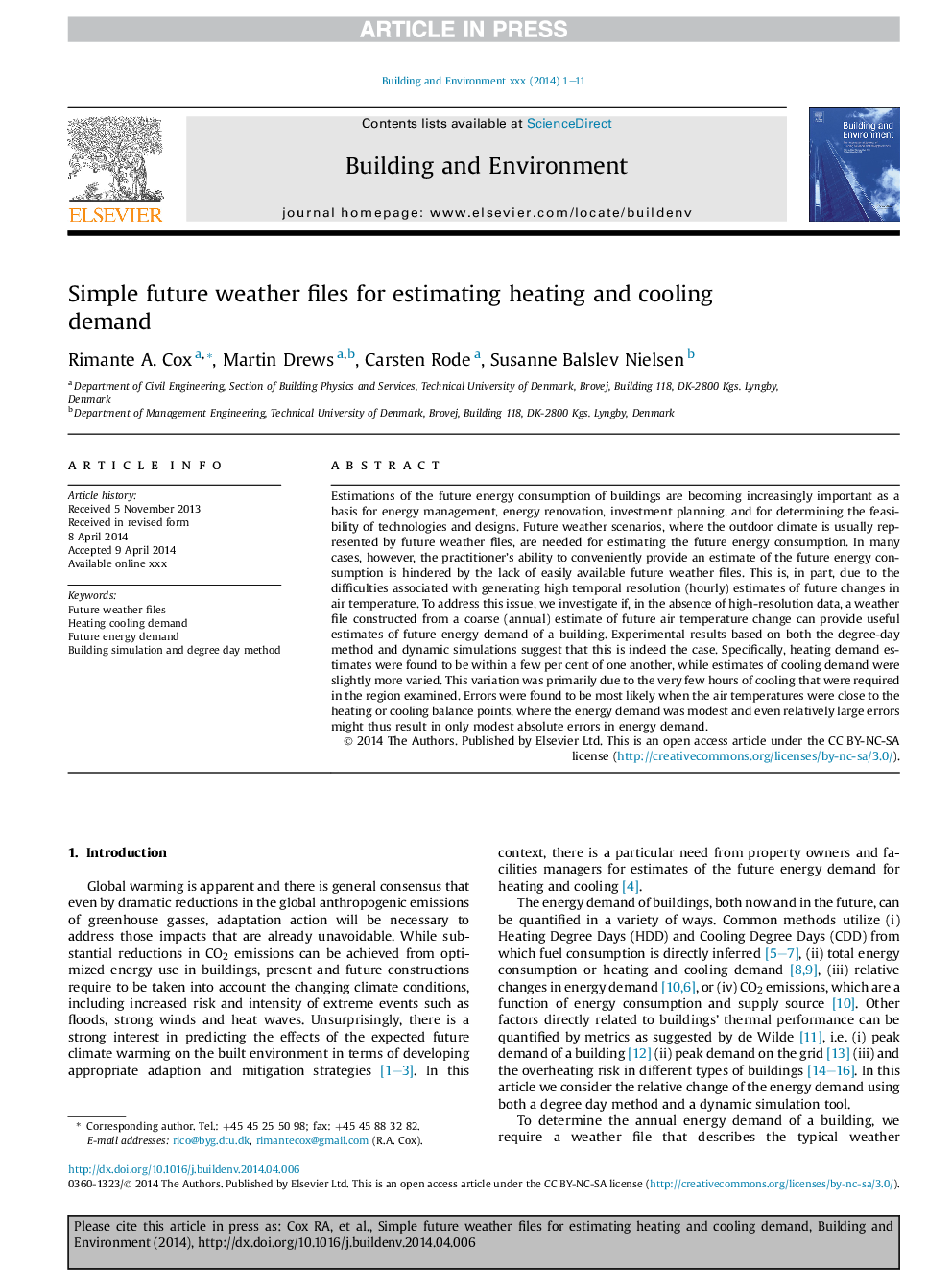| کد مقاله | کد نشریه | سال انتشار | مقاله انگلیسی | نسخه تمام متن |
|---|---|---|---|---|
| 6700054 | 502542 | 2015 | 11 صفحه PDF | دانلود رایگان |
عنوان انگلیسی مقاله ISI
Simple future weather files for estimating heating and cooling demand
ترجمه فارسی عنوان
پرونده های آب و هوایی ساده برای تخمین تقاضای حرارت و خنک کننده
دانلود مقاله + سفارش ترجمه
دانلود مقاله ISI انگلیسی
رایگان برای ایرانیان
کلمات کلیدی
فایل های هواشناسی آینده تقاضای حرارت دادن خنک کننده تقاضای انرژی آینده شبیه سازی ساختمان و روش روز درجه،
ترجمه چکیده
برآورد مصرف انرژی آینده در ساختمان ها به عنوان پایه ای برای مدیریت انرژی، نوسازی انرژی، برنامه ریزی سرمایه گذاری و تعیین امکان پذیری فن آوری ها و طرح ها به عنوان مهمتر به نظر می رسد. سناریوهای آب و هوایی آینده، جایی که آب و هوای بیرونی معمولا توسط پرونده های آب و هوایی آینده نشان داده می شود، برای ارزیابی مصرف انرژی آینده مورد نیاز است. با این حال، در بسیاری از موارد، توانایی تمرینکننده برای راحتی تخمینی از مصرف انرژی در آینده، به دلیل عدم دسترسی آسان به اطلاعات موجود در هوا، مانع میشود. این بخشی است که به علت مشکلات ناشی از ایجاد تخمین های طولانی مدت (ساعتی) برآورد تغییرات در دمای هوا در طول زمان است. برای رسیدگی به این مسئله، اگر فاقد اطلاعات با رزولوشن بالا، یک فایل هواشناسی ساخته شده از یک برآورد (بر اساس سالانه) تغییرات دمای هوا در آینده، بتوانیم برآوردهای مفیدی از نیاز انرژی آینده در یک ساختمان ارائه دهیم، بررسی می کنیم. نتایج تجربی بر اساس روش روزانه روزانه و شبیه سازی های پویا نشان می دهد که در واقع این مورد است. به طور خاص، برآوردهای تقاضای گرما در عرض چند درصد از یکدیگر قرار داشت، در حالیکه برآورد تقاضای خنک کننده کمی متفاوت بود. این تنوع در درجه اول به دلیل چند ساعت خنک کننده که در ناحیه مورد بررسی مورد نیاز بود، بود. هنگامی که درجه حرارت هوا نزدیک به نقطه تعادل گرما یا خنک کننده بود، تقاضای انرژی کم است و حتی اشتباهات نسبتا بزرگ ممکن است فقط خطاهای مطلق کم در تقاضای انرژی ایجاد شود.
موضوعات مرتبط
مهندسی و علوم پایه
مهندسی انرژی
انرژی های تجدید پذیر، توسعه پایدار و محیط زیست
چکیده انگلیسی
Estimations of the future energy consumption of buildings are becoming increasingly important as a basis for energy management, energy renovation, investment planning, and for determining the feasibility of technologies and designs. Future weather scenarios, where the outdoor climate is usually represented by future weather files, are needed for estimating the future energy consumption. In many cases, however, the practitioner's ability to conveniently provide an estimate of the future energy consumption is hindered by the lack of easily available future weather files. This is, in part, due to the difficulties associated with generating high temporal resolution (hourly) estimates of future changes in air temperature. To address this issue, we investigate if, in the absence of high-resolution data, a weather file constructed from a coarse (annual) estimate of future air temperature change can provide useful estimates of future energy demand of a building. Experimental results based on both the degree-day method and dynamic simulations suggest that this is indeed the case. Specifically, heating demand estimates were found to be within a few per cent of one another, while estimates of cooling demand were slightly more varied. This variation was primarily due to the very few hours of cooling that were required in the region examined. Errors were found to be most likely when the air temperatures were close to the heating or cooling balance points, where the energy demand was modest and even relatively large errors might thus result in only modest absolute errors in energy demand.
ناشر
Database: Elsevier - ScienceDirect (ساینس دایرکت)
Journal: Building and Environment - Volume 83, January 2015, Pages 104-114
Journal: Building and Environment - Volume 83, January 2015, Pages 104-114
نویسندگان
Rimante A. Cox, Martin Drews, Carsten Rode, Susanne Balslev Nielsen,
